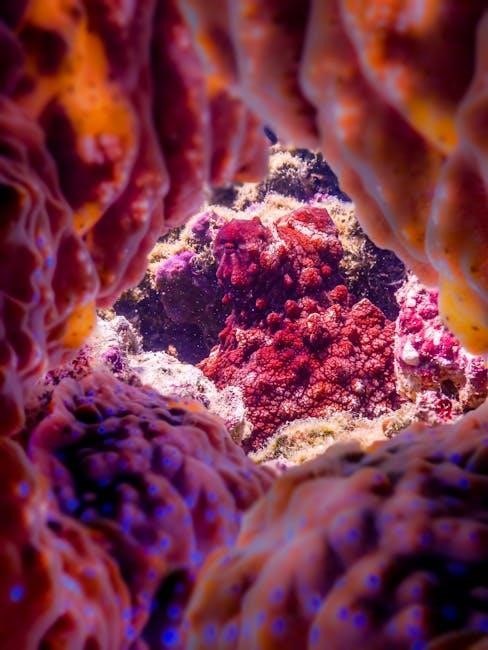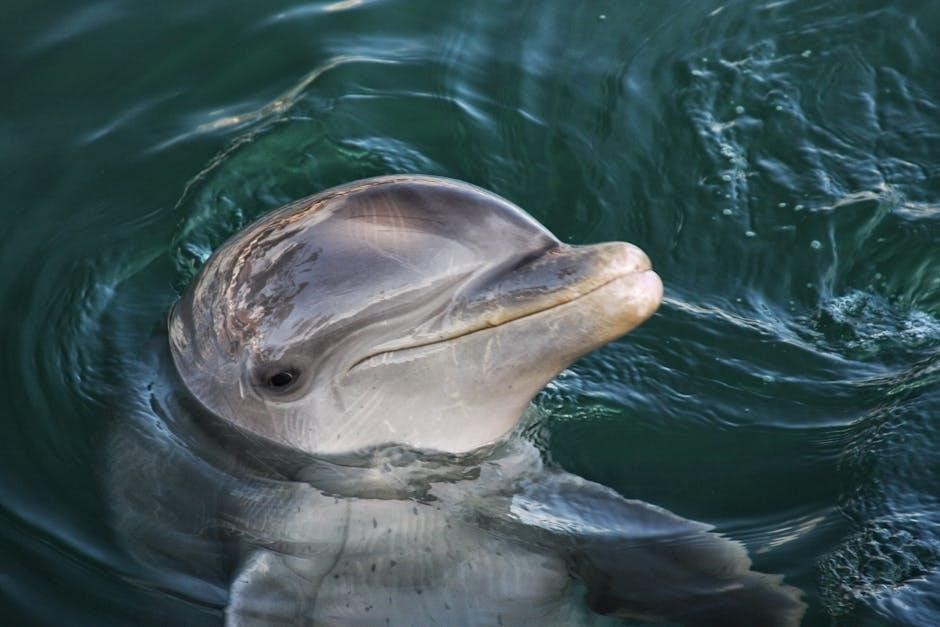
smart marine guide
The Smart Marine Guide introduces an innovative approach to maritime operations, integrating advanced technologies to enhance efficiency, safety, and sustainability in the marine industry globally.
1.1 Definition and Scope of Smart Marine Guide
The Smart Marine Guide is a comprehensive framework that leverages cutting-edge technologies to optimize maritime operations. It encompasses the integration of IoT, AI, and big data to enhance efficiency, safety, and environmental sustainability. The scope includes advanced navigation systems, predictive maintenance, and real-time data analytics. It addresses challenges in vessel operations, marine pollution, and resource management. By fostering innovation, the guide promotes sustainable practices and compliance with international regulations. Its applications span from commercial shipping to environmental monitoring, ensuring a holistic approach to modern maritime challenges.
1.2 Importance of Smart Marine Systems in Modern Maritime Industry
Smart marine systems are pivotal in transforming the maritime industry, offering enhanced operational efficiency, safety, and environmental sustainability. They enable real-time monitoring, predictive maintenance, and data-driven decision-making, reducing costs and downtime. These systems also improve navigation accuracy, minimizing risks of collisions and environmental damage. Furthermore, they facilitate compliance with stringent international regulations, ensuring safer and more responsible maritime practices. By integrating advanced technologies, smart marine systems address the growing demand for sustainable solutions, making them indispensable in the modern maritime landscape.
1.3 Overview of Key Technologies in Smart Marine Guide
The Smart Marine Guide leverages cutting-edge technologies to revolutionize maritime operations. Key technologies include the Internet of Things (IoT), Artificial Intelligence (AI), and Predictive Maintenance, ensuring real-time monitoring and data-driven decision-making. GPS and AIS integration enhances navigation accuracy, while Big Data Analytics provides insights for operational optimization. Automation and Robotics streamline tasks, reducing human intervention. Renewable Energy Solutions and Eco-Friendly Vessel Design promote sustainability. Advanced Navigation Tools and Data Visualization further support efficient and safe maritime practices. These technologies collectively address modern challenges, fostering a more efficient, safe, and environmentally responsible maritime industry.

Marine IoT (Internet of Things)
Marine IoT enables real-time monitoring of ships and marine environments through sensors and data analytics, enhancing operational efficiency, safety, and sustainability in the maritime industry.
2.1 Applications of IoT in Marine Industry
The Internet of Things (IoT) transforms the marine industry through various applications, including vessel tracking, environmental monitoring, and predictive maintenance. IoT sensors monitor vessel health, optimizing performance and reducing downtime. Real-time data from IoT devices enables fleet management, improving route efficiency and fuel consumption. Additionally, IoT supports cargo management, ensuring safe and secure transport of goods; It also enhances marine safety by detecting potential risks like collisions or equipment failures. Furthermore, IoT aids in environmental conservation by tracking water quality and preventing pollution. These applications collectively drive operational excellence, sustainability, and innovation in the maritime sector, making IoT indispensable for modern marine operations.
2.2 Benefits of IoT for Marine Operations
The integration of IoT in marine operations offers numerous benefits, including enhanced operational efficiency, improved safety, and cost savings. IoT enables real-time monitoring of vessel performance, allowing for predictive maintenance and reducing unplanned downtime. This leads to extended equipment lifespan and lower operational expenses. IoT also improves navigation accuracy through advanced sensors, reducing the risk of accidents. Additionally, IoT supports environmental sustainability by optimizing fuel consumption and minimizing emissions. The ability to collect and analyze vast amounts of data enables data-driven decision-making, fostering innovation and competitiveness in the maritime industry. Overall, IoT creates a more connected, efficient, and sustainable marine ecosystem, addressing critical challenges and driving future advancements.
2.3 Challenges and Limitations of IoT in Marine Environments
Despite its benefits, IoT implementation in marine environments faces several challenges. Connectivity issues arise due to limited internet access in remote maritime areas, disrupting real-time data transmission. Data management complexity increases with the sheer volume of information generated, requiring robust analytics systems. Cybersecurity risks are heightened, as connected devices become vulnerable to hacking. Additionally, harsh environmental conditions at sea, such as extreme weather and saltwater exposure, can damage IoT devices. High installation and maintenance costs further hinder widespread adoption. Lastly, standardization issues across different systems and protocols complicate integration. These challenges underscore the need for innovative solutions to fully realize IoT’s potential in the marine industry.

Artificial Intelligence in Maritime Safety
AI enhances maritime safety through advanced risk assessment, predictive maintenance, and real-time monitoring. It improves incident response and reduces human error, ensuring safer marine operations globally.
3.1 Role of AI in Risk Analysis and Prediction
AI plays a pivotal role in maritime risk analysis by leveraging machine learning algorithms to analyze historical and real-time data, identifying potential hazards and predicting risks. By processing vast amounts of information, AI systems can detect patterns and anomalies that may lead to accidents or operational disruptions. This enables proactive measures to mitigate risks, such as adjusting routes to avoid severe weather or identifying equipment malfunctions before they escalate. AI’s predictive capabilities enhance decision-making, ensuring safer navigation and reducing the likelihood of environmental incidents. Its ability to simulate scenarios and forecast outcomes makes it an indispensable tool for improving maritime safety and operational efficiency.
3.2 AI-Driven Predictive Maintenance for Marine Equipment
AI-driven predictive maintenance revolutionizes marine equipment upkeep by enabling early detection of potential failures. Through advanced sensors and real-time data analysis, AI systems monitor equipment performance, identifying anomalies and predicting breakdowns before they occur. This proactive approach minimizes unplanned downtime, reduces repair costs, and enhances operational reliability. Machine learning algorithms analyze historical maintenance data, enabling precise predictions and personalized maintenance schedules. For instance, AI can detect early signs of engine wear or propeller degradation, allowing for timely interventions. By optimizing maintenance routines, AI-driven systems extend equipment lifespan, reduce resource consumption, and ensure safer marine operations. This technology is critical for maintaining efficiency and safety in the modern maritime industry.
3.3 Case Studies of AI Implementation in Maritime Safety
AI has been successfully implemented in maritime safety through various case studies. For example, AI-powered systems have been used to detect illegal fishing activities by analyzing satellite data and AIS signals, helping to enforce maritime regulations. Another case involves AI-driven collision avoidance systems, which use real-time data from multiple sources to predict potential collisions and suggest evasive maneuvers. Additionally, AI has been employed in monitoring marine pollution, identifying oil spills, and tracking their spread using satellite imagery. These implementations highlight AI’s role in enhancing safety, reducing illegal activities, and protecting the marine environment. Such case studies demonstrate the transformative potential of AI in addressing critical maritime safety challenges.

Smart Navigation Systems
Smart navigation systems enhance maritime operations by integrating GPS, AIS, and advanced tools for real-time decision-making, optimizing routes, and adapting to environmental conditions, ensuring safer and more efficient voyages.
4.1 GPS and AIS (Automatic Identification System) Integration
The integration of GPS and AIS technologies revolutionizes marine navigation by providing precise location data and real-time vessel tracking. GPS offers accurate positioning, while AIS enhances safety by sharing ship information with nearby vessels and coastal authorities. Together, they improve collision avoidance, optimize routing, and ensure regulatory compliance. This integration supports smarter decision-making, reduces operational risks, and enhances overall maritime efficiency. By combining these systems, mariners gain a comprehensive view of their surroundings, enabling safer and more efficient voyages. This synergy is a cornerstone of modern navigation, driving the adoption of smart marine technologies globally.
4.2 Advanced Navigation Tools for Real-Time Decision Making
Advanced navigation tools empower mariners with real-time data, enabling informed decision-making at sea. These tools leverage AI, machine learning, and big data to analyze weather patterns, sea conditions, and vessel performance. By integrating sensors and satellite imagery, they provide holistic situational awareness, optimizing route planning and fuel efficiency. Predictive analytics further enhance safety by anticipating potential risks, such as collisions or equipment failures. These systems also support environmental compliance by identifying protected areas and minimizing ecological impact. As a result, advanced navigation tools are critical for modern maritime operations, ensuring safer, more efficient, and sustainable voyages in an increasingly complex marine environment.
4.3 Future Trends in Marine Navigation Technologies
Future marine navigation technologies will focus on autonomous systems, enhanced connectivity, and sustainability. Autonomous vessels powered by AI and machine learning will revolutionize shipping, reducing human error and optimizing routes. Integration of 5G and satellite communications will enable real-time data sharing, improving navigation accuracy. Eco-friendly navigation tools will prioritize fuel efficiency and emissions reduction. Predictive analytics will anticipate weather patterns and potential risks, enhancing safety. Augmented reality will provide immersive navigation experiences, aiding mariners in complex scenarios. These advancements promise to transform the maritime industry, ensuring safer, more efficient, and environmentally responsible operations. As these technologies evolve, they will set new standards for global marine navigation.

Sustainable Marine Practices
Sustainable marine practices focus on eco-friendly vessel design, renewable energy solutions, and reducing pollution to promote environmental stewardship and long-term maritime industry viability.
5.1 Eco-Friendly Vessel Design and Energy Efficiency

Eco-friendly vessel design prioritizes energy efficiency through lightweight materials, optimized hull shapes, and hybrid propulsion systems. These innovations reduce fuel consumption and lower emissions, aligning with global environmental standards.
5.2 Renewable Energy Solutions for Marine Operations
Renewable energy solutions are transforming marine operations by reducing reliance on fossil fuels. Solar panels, wind turbines, and wave energy converters are being integrated into vessels and coastal infrastructures. These technologies harness natural resources to power ships and support marine activities, significantly lowering greenhouse gas emissions. Energy storage systems, such as advanced batteries, ensure consistent power supply despite intermittent renewable sources. Adoption of these solutions aligns with global sustainability goals, helping the maritime industry meet stringent environmental regulations while promoting eco-friendly practices. This shift not only addresses climate change but also enhances energy efficiency and operational reliability in marine environments.
5.3 Reducing Marine Pollution Through Smart Technologies
Smart technologies play a pivotal role in combating marine pollution by identifying and mitigating its sources. Advanced sensors and IoT devices monitor water quality in real-time, detecting pollutants like oil spills or plastic waste. AI-powered systems analyze data to predict pollution hotspots, enabling proactive measures. Autonomous underwater vehicles (AUVs) and drones are deployed for cleanup operations, while blockchain technology ensures transparent tracking of waste management. These innovations not only reduce contamination but also promote sustainable practices, helping to preserve marine ecosystems. By integrating cutting-edge tools, the maritime industry can significantly minimize its environmental impact and contribute to a healthier ocean for future generations.

Marine Data Analytics
Marine Data Analytics leverages big data, AI, and IoT to transform maritime operations, enabling informed decision-making through real-time insights and predictive analysis.
6.1 Big Data in Marine Research and Operations
Big data plays a pivotal role in modern marine research and operations by enabling the analysis of vast datasets from various sources, such as IoT devices, sensors, and historical records. This data is crucial for understanding ocean dynamics, predicting weather patterns, and optimizing maritime routes. Advanced analytics tools process this information to provide actionable insights, improving operational efficiency and safety. For instance, real-time data from AIS and GPS systems helps in tracking vessel movements, reducing collisions, and enhancing navigation. Additionally, big data supports environmental monitoring, aiding in conservation efforts and sustainable resource management. The integration of big data analytics has revolutionized how the marine industry approaches challenges, driving innovation and fostering a data-driven culture.
6.2 Real-Time Data Monitoring for Marine Environments
Real-time data monitoring is essential for understanding and managing marine environments effectively. Sensors and IoT devices deployed across oceans and waterways collect vast amounts of data, including water temperature, salinity, and pollution levels. This information is transmitted instantly to monitoring systems, enabling prompt responses to environmental changes. For example, real-time data helps track marine life migration patterns, detect illegal fishing activities, and monitor the impact of climate change. Advanced tools like AIS and GPS further enhance the accuracy of these systems, ensuring safer navigation and reducing ecological risks. By leveraging real-time data, stakeholders can make informed decisions, protect marine ecosystems, and promote sustainable practices in the maritime industry.
6.3 Data Visualization Tools for Marine Insights
Data visualization tools play a crucial role in transforming complex marine data into actionable insights. These tools enable the creation of interactive and dynamic representations of oceanographic data, such as water temperature, currents, and marine life distributions. Technologies like GIS mapping, interactive dashboards, and 3D modeling allow users to explore patterns and trends in marine environments. Real-time data from sensors and satellites can be visualized to monitor ecological changes, track marine biodiversity, and predict climate impacts. By simplifying data interpretation, these tools support decision-making for conservation efforts, sustainable fishing practices, and coastal management. They also facilitate collaboration among researchers, policymakers, and stakeholders to address marine challenges effectively.

Automation and Robotics in Marine Environments
Automation and robotics revolutionize marine operations by enhancing efficiency, safety, and environmental monitoring. These technologies enable underwater exploration, maintenance, and data collection, reducing human intervention and costs significantly.
7.1 Types of Marine Robots and Their Applications
Marine robots, such as Autonomous Underwater Vehicles (AUVs), Remotely Operated Vehicles (ROVs), and Unmanned Surface Vehicles (USVs), play a crucial role in ocean exploration and monitoring. AUVs are used for underwater surveys, environmental monitoring, and search operations, while ROVs are deployed for deep-sea inspections and maintenance tasks. USVs operate on the water surface, collecting data on water quality and weather conditions. Additionally, bio-inspired robots mimic marine life, enhancing maneuverability in complex environments. These technologies enable efficient data collection, reduce risks to human life, and support marine conservation efforts, making them indispensable in modern marine operations and research.
7.2 Autonomous Underwater Vehicles (AUVs) and Their Roles
Autonomous Underwater Vehicles (AUVs) are unmanned underwater robots designed to perform complex tasks without human intervention. They are widely used for oceanographic research, hydrographic surveys, and environmental monitoring. AUVs collect data on water temperature, salinity, and marine life, aiding in climate change studies and ecosystem preservation. They also play a key role in search and recovery missions, detecting underwater objects like shipwrecks or black boxes from aircraft. Additionally, AUVs are employed in offshore oil and gas exploration to inspect pipelines and infrastructure. Their ability to operate in harsh environments reduces risks to human life and enhances the efficiency of marine operations, making them indispensable in advancing ocean exploration and management.
7.3 Robotics for Environmental Monitoring and Cleanup
Robots play a pivotal role in environmental monitoring and cleanup, particularly in marine ecosystems. They are equipped with sensors to detect water quality, track marine life, and identify pollution sources. Advanced robotic systems can collect plastic waste, oil spills, and other debris, restoring marine habitats. These devices often operate autonomously, reducing human intervention in dangerous or hard-to-reach areas. By providing real-time data, robots enable scientists to address environmental issues promptly. Their precision in cleanup tasks minimizes harm to marine life, making them invaluable tools for sustainable ocean management and conservation efforts, ultimately safeguarding marine biodiversity and ecosystems for future generations.

Legal and Ethical Considerations
The Smart Marine Guide addresses legal and ethical considerations, ensuring compliance with international maritime laws, data privacy, and environmental sustainability, while prioritizing cybersecurity and ethical AI deployment.
8.1 International Regulations for Smart Marine Technologies
International regulations play a crucial role in governing the adoption of smart marine technologies. The International Maritime Organization (IMO) sets global standards for maritime safety, environmental protection, and efficiency. These regulations ensure that smart marine systems, such as IoT devices and AI-driven solutions, comply with international laws and protocols. For instance, the SOLAS (Safety of Life at Sea) convention mandates the use of advanced navigation tools, while MARPOL focuses on reducing marine pollution through eco-friendly technologies. Compliance with these regulations is essential for maintaining global maritime security, promoting sustainable practices, and fostering innovation in the industry. Adherence to international standards also facilitates collaboration among countries and organizations, ensuring a unified approach to smart marine technologies.
8.2 Ethical Implications of AI and IoT in Marine Industry
The integration of AI and IoT in the marine industry raises significant ethical considerations. Privacy concerns arise as IoT devices collect vast amounts of data, potentially infringing on the privacy of crew, passengers, and coastal communities. Additionally, the environmental impact of AI systems, such as energy consumption and e-waste generation, must be addressed to ensure sustainability. Accountability is another critical issue, as autonomous systems blur the lines of responsibility in decision-making processes. Furthermore, the potential for bias in AI algorithms could lead to unfair treatment or discrimination in maritime operations. These ethical challenges highlight the need for transparent policies and frameworks to guide the responsible use of these technologies.
8.3 Cybersecurity in Smart Marine Systems
Cybersecurity is a critical concern in smart marine systems, as the increasing reliance on IoT and AI technologies creates vulnerabilities. Marine systems, such as navigation tools and autonomous vessels, are prime targets for cyberattacks, which could lead to data breaches, operational disruptions, or even safety risks. Protecting these systems requires robust encryption, secure authentication protocols, and regular software updates. Additionally, compliance with international maritime cybersecurity standards is essential to safeguard sensitive information and ensure uninterrupted operations. The industry must also invest in training personnel to recognize and respond to potential threats, as human error remains a significant factor in cybersecurity incidents. Addressing these challenges is vital to maintain trust and security in the evolving smart marine ecosystem.

Future Trends in Smart Marine Guide
Future trends in the Smart Marine Guide include the rise of autonomous vessels, advanced data analytics, and sustainable energy solutions, driving innovation and global maritime collaboration.
9.1 Emerging Technologies in Marine Industry
Emerging technologies in the marine industry are transforming operations through advancements in autonomous systems, artificial intelligence, and IoT. Autonomous vessels are being developed for efficient cargo transport, reducing human intervention. AI-driven systems optimize route planning, predictive maintenance, and safety monitoring. IoT sensors enable real-time data collection from vessels and marine environments, improving decision-making. Big data analytics is revolutionizing operational efficiency by providing insights into performance metrics. Additionally, advancements in cybersecurity are critical to protect smart marine systems from evolving threats. These innovations are paving the way for a more sustainable, efficient, and connected maritime future, addressing global challenges like climate change and resource management.
9.2 Potential Challenges for Future Smart Marine Systems
The adoption of smart marine systems faces several challenges, including cybersecurity threats, data privacy concerns, and high implementation costs. The complexity of integrating advanced technologies with existing infrastructure can delay adoption. Limited availability of skilled personnel to maintain and update systems is another hurdle. Additionally, environmental factors like extreme weather conditions can impact the reliability of smart marine equipment. Regulatory frameworks must evolve to keep pace with technological advancements, ensuring compliance and safety. Addressing these challenges requires collaboration among stakeholders to develop robust solutions and ensure the long-term sustainability of smart marine technologies in the maritime industry.
9.3 Global Collaboration for Advancements in Smart Marine Guide
Global collaboration is essential for driving advancements in the Smart Marine Guide, fostering innovation, and addressing shared challenges. International partnerships enable the sharing of knowledge, resources, and expertise, accelerating the development of smart marine technologies. By working together, nations can establish standardized protocols for data sharing, ensuring interoperability across systems. Collaboration also facilitates the creation of global frameworks for ethical AI and IoT use in maritime industries. Initiatives like joint research projects and cross-border pilot programs can demonstrate the benefits of smart marine systems. Strong international cooperation will ensure that the Smart Marine Guide evolves to meet global needs, promoting sustainability, safety, and efficiency across the maritime sector.
The Smart Marine Guide represents a transformative approach, enhancing maritime operations through technology, sustainability, and global collaboration, paving the way for a safer and more efficient future.
10.1 Summary of Key Points in Smart Marine Guide
The Smart Marine Guide encapsulates the integration of cutting-edge technologies like IoT, AI, and advanced navigation systems to revolutionize maritime operations. It emphasizes sustainability through eco-friendly vessel designs and renewable energy solutions. AI-driven predictive maintenance and real-time data analytics enhance safety and efficiency. Robotics and automation play a crucial role in environmental monitoring and pollution reduction. Legal and ethical considerations, including cybersecurity, are addressed to ensure responsible technology adoption. The guide also explores future trends, such as emerging technologies and global collaboration, which are essential for overcoming challenges and fostering innovation. These advancements collectively pave the way for a smarter, greener, and more resilient maritime industry.
10.2 Final Thoughts on the Evolution of Smart Marine Systems
The evolution of smart marine systems has revolutionized the maritime industry, driving it toward a more efficient, sustainable, and technologically advanced future. The integration of AI, IoT, and data analytics has transformed operations, enhancing safety, reducing environmental impact, and optimizing resource utilization. As these technologies continue to evolve, the industry must embrace innovation while addressing challenges like cybersecurity and ethical considerations. Collaboration between stakeholders will be crucial to overcoming obstacles and ensuring the responsible adoption of smart marine technologies. By fostering a culture of continuous improvement, the maritime sector can navigate the complexities of modern demands while paving the way for a smarter, greener, and more resilient future.
10.3 Call to Action for Adoption of Smart Marine Technologies
The maritime industry must actively embrace smart marine technologies to stay competitive and address global challenges. Stakeholders should prioritize investments in AI, IoT, and data analytics to unlock operational efficiencies and sustainability. Collaboration between governments, corporations, and researchers is essential to drive innovation and establish standardized frameworks. By adopting these technologies, the industry can reduce environmental impact, enhance safety, and improve decision-making. Encourage organizations to explore tailored solutions and participate in pilot programs to test emerging tools. The time to act is now—embracing smart marine systems will ensure a resilient and forward-thinking maritime future for generations to come.